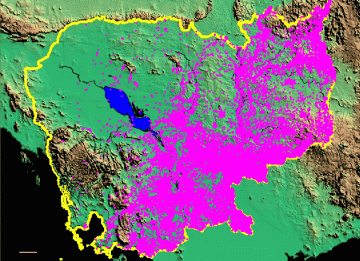U.S. Involvement in the Cambodian War and Genocide
The United States Bombing of Cambodia, 1965-1973
The United States Bombing of Cambodia, 1965-1973
1. Kenton Clymer, The United States and Cambodia, 1870-1969: From Curiosity to Confrontation (New York and London: Routledge, 2004); and vol. II, The United States and Cambodia, 1969-2000: A Troubled Relationship (Routledge, 2004).
2. “The US Bombardment of Cambodia, 1969-1973,” by Ben Kiernan, Vietnam Generation, 1: 1, Winter 1989, pp. 4-41. “Bombs over Cambodia” (Walrus magazine, Oct. 2006); “Roots of U.S. Troubles in Afghanistan: Civilian Bombing Casualties and the Cambodian Precedent,” by Ben Kiernan and Taylor Owen, The Asia-Pacific Journal, 26-4-10,June 28, 2010.
3. Ben Kiernan and Taylor Owen, “Making More Enemies Than We Kill?” Calculating US Bomb Tonnages Dropped on Laos and Cambodia, and Weighing their Implications,” Asia-Pacific Journal, vol. 13, issue 16, no. 3, April 27, 2015.
4. Nixon and Kissinger escalate the bombing of Cambodia, Dec. 9, 1970 (declassified transcripts of telephone conversations):
Document 1: Nixon and Kissinger
Document 2: Kissinger and Haig
5. William Shawcross, Sideshow: Kissinger, Nixon and the Destruction of Cambodia (New York, Simon and Schuster, 1979).
6. Ben Kiernan, How Pol Pot Came to Power: Colonialism, Nationalism and Communism in Cambodia, 1930-1975 (London, Verso, 1985; 2nd ed., Yale University Press, 2004), pp. 285-86, 349-61, 370-71, 389ff.
7. CGP Interactive Maps of the US bombardment of Cambodia, 1965-1973, and the Khmer Rouge genocide, 1975-1979.
United States Policy on the Khmer Rouge regime, 1975-1979
1. Kenton Clymer, The United States and Cambodia, 1969-2000: A Troubled Relationship(New York and London: Routledge, 2004)
Kissinger: “You should also tell the Cambodians that we will be friends with them. They are murderous thugs, but we won’t let that stand in our way. We are prepared to improve relations with them.”
3. Ford and Kissinger discuss Cambodia with Indonesia’s President Suharto, Jakarta, December 5, 1975
4. Former US National Security Adviser, Zbigniew Brzezinski, on China and the Khmer Rouge, 1979:
“I encouraged the Chinese to support Pol Pot. Pol Pot was an abomination. We could never support him, but China could.” According to Brzezinski, the USA “winked, semi-publicly” at Chinese and Thai aid to the Khmer Rouge.
(Elizabeth Becker, When the War Was Over, New York, Touchstone, 1986, p. 440. See also Grant Evans and Kelvin Rowley, Red Brotherhood at War: Vietnam, Cambodia and Laos since 1975, London, Verso, rev. ed., 1990.)
Readings on US Cambodia Policy since 1979
1. Michael Haas, Cambodia, Pol Pot, and the United States: the Faustian pact, New York: Praeger, 1991.
2. Michael Haas, Genocide by proxy: Cambodian pawn on a superpower chessboard, New York: Praeger, 1991.
3. Ben Kiernan, “The Inclusion of the Khmer Rouge in the Cambodian Peace Process: Causes and Consequences,” in Kiernan, ed., Genocide and Democracy in Cambodia: The Khmer Rouge, the United Nations, and the International Community, New Haven, Yale Council on Southeast Asia Studies/Orville H. Schell, Jr. Center for International Human Rights, 1993, pp. 191-272.
4. Ben Kiernan, “The Cambodian Genocide and Imperial Culture,” Aztag Daily, April 2005
